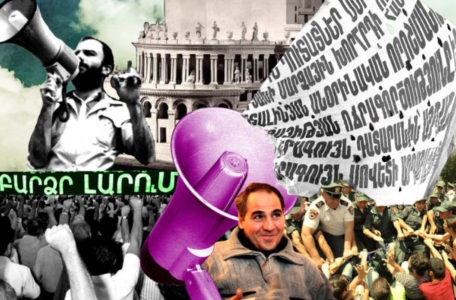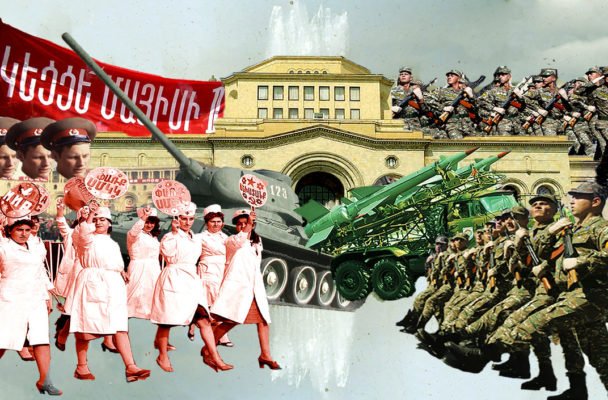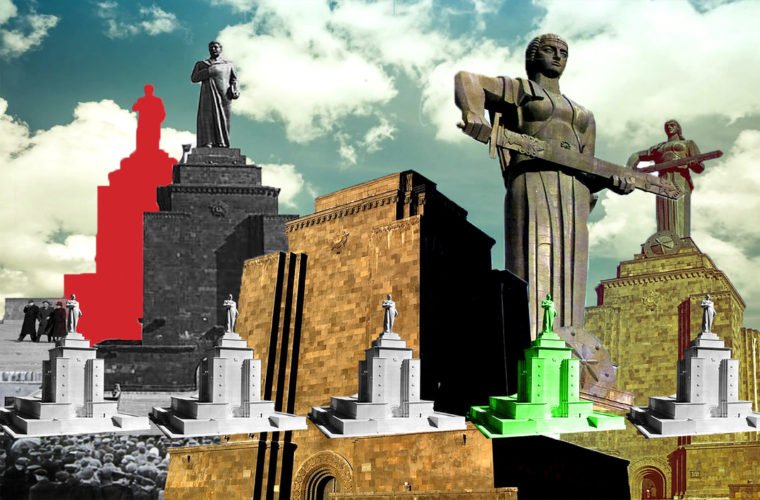
“Memory is a political act. Forgetfulness is the handmaiden of tyranny.”
James Carroll
Conventionally, memory is perceived as something related to the past and often as the mirror of the past. Even though memory is often interpreted as a reflection of the past, it is actually a narrative of the past that lives in the present and can influence the future. Memory, going hand in hand with forgetting, is an archived interpretation of the past, a constructed version of the past, which can play a role in the continuity between past and present – in “establishing social cohesion, legitimizing authority and socializing populations into a common culture” (Hobsbawm and Ranger 1983).
On the other hand, the politics of memory, according to Hobsbawm’s analysis in The Invention of Tradition, is an “exercise … in social engineering” from above, by political agents, meaning that “the history, which became part of the fund of knowledge or the ideology of the nation, state or movement is not what has actually been preserved in popular memory, but what has been selected, written, pictured, popularized and institutionalized by those whose function it is to do so” (Hobsbawm and Ranger 1983, 12). So, while memory and collective memory do contribute to a bottom-up process, that is the memory of a group affects the politics of memory, there is also a top-down process, where the politics of memory selectively records or pushes into oblivion elements of the past. Memorialization is an important instrument of the politics of memory: the choice of what to memorialize, or perhaps even more significantly, what not to memorialize, exerts an effect on the collective memory of a society.
The purpose of this paper is to study the transformation of the post-Soviet memorial landscape of Yerevan and the politics of memory in the Third Republic of Armenia since the collapse of the Soviet Union. We will focus on the physical and perceptual transformations of some of the public spaces, as well as the Soviet and post-Soviet memorials in Yerevan.
Memorials and the memory related to them most often undergo transformations during revolutions and cataclysms (Abrahamyan 2003). First with the Perestroika and then the collapse of the Soviet Union, a re-evaluation of the Soviet past, heroes, and idolized figures started. Cultural anthropologist Levon Abrahamyan refers to the work of Vladimir Paperny, who distinguished two types of cultures, that alternated throughout the Soviet era, based on their approaches to dealing with the past – Revolutionary Culture or Culture One and Totalitarian Culture or Culture Two (Paperny 1996). The Revolutionary Culture first sought to destroy the remains of the past, and only then constructed the new from scratch. The Totalitarian Culture engulfed the old and the new into one, declaring itself as the end of history (Paperny 1996, 315). Among the first “targets” of these two cultures were undoubtedly memorials. The post-Soviet treatment of memorials across the entire territory of the ex-Union, as Levon Abrahamyan mentions, is closer to the type of Revolutionary Culture (Abrahamyan 2003, 25). As in all other ex-Soviet republics, in Armenia as well, the collapse of the Soviet Union was followed by the so-called war against Soviet memory. The “war” started by renaming public spaces and the removal of statues of communist figures.
Thus, the process of renaming often takes place during or after revolutions or other major political changes, as they hail the construction of the new and destruction of everything that is related to the past. An impressive example of renaming in Armenia, done by the people, was that of the Theatre Square into Freedom Square, one of the most popular squares of Yerevan. And it is with this space that we will start our tour of the post-Soviet transformations of the memory landscape in Yerevan.
How a “Festival” Turned Theater Square into Freedom Square
Collage "The Freedom Square". Credits: Mher Kafalian.
Preceding the independence of Armenia, the Karabakh movement broke out, which was a mass nationalist movement in Armenia and Nagorno-Karabakh that started in 1988 and that first aimed for the transfer of the Nagorno-Karabakh Autonomous Oblast of neighboring Azerbaijan to the jurisdiction of Armenia and then the independence of Nagorno-Karabakh. The movement had two wings – one in Yerevan, Armenia and the other one in Stepanakert [1] , Nagorno-Karabakh. On February 19, 1988, several thousand people gathered in the Theater Square of Yerevan to support the Armenians of Karabakh, who had gathered in another square in Stepanakert, demanding to be united with Armenia.
As Levon Abrahamyan explains, the Theater Square became a festive square within the context of events leading to the collapse of the Soviet Union (Abrahamyan 2006). As the number of people in the square reached half a million, the movement led to an outburst of a sense of national self-consciousness. Levon Abrahamyan compares the demonstrations to a proto-festival that implies the abolition of social hierarchies, such as binary oppositions between men and women, townspeople and villagers, Russian speakers and Armenian speakers, etc. Just like during medieval festivals, the ordinary cosmos of everyday life transforms into a chaotic celebration, which is what happened in the Theater Square in 1988 (Abrahamyan 2006, 224). Due to these processes, people rewarded the square with the name “Freedom”. The new name of the square became popular during the movement, and people would refer to it as either “Independence Square” or “Freedom Square”. Since then, the square has become a venue of many mass protests, symbolizing the ideas and values created during the above-mentioned chaotic festival, such as democracy and freedom of speech.
The Demolition of Lenin’s Monument: Between Aesthetics and Ideology
Collage "The Republic Square". Credits: Mher Kafalian.
In line with the process of renaming many streets and public spaces in Yerevan, another popular square, the Lenin Square with a grand statue of Lenin was renamed into Republic Square. The Lenin Square was the central square of Yerevan, embodying the state philosophy. The square would host all the biggest celebrations of the Soviet Republic, including the parade on Labor Day on May 1, and military parades on Victory Day against Nazism on May 9, and October Revolution Parade on November 7. The square stayed loyal to its former duty of serving the ruling power, in contrast to Freedom Square, “the square of the people”. The renamed Square continued hosting military parades in post-Soviet Armenia to celebrate the independence of the republic on September 21 of 1996 (5th anniversary), 1999 (8th anniversary), 2006 (15th anniversary), 2011 (20th anniversary), and 2016 (25th anniversary) (Asbarez.com 2016), manifesting the Soviet pattern of a military state reborn in independent Armenia. It is worth mentioning that May 9 remains Victory Day in the post-Soviet period, but it has been reinforced as a day of victory by the celebration of the takeover of the city Shushi/Shusha in Nagorno-Karabakh in 1992.
Supplementary to the renaming of the square, its main symbol, the statue of Lenin was demolished in 1991. Ironically, aside from political statements, aesthetic statements also played a role in the war against Soviet monuments (Abrahamyan 2003). In his speech preceding the demolition ceremony, Mayor of that time Hambardzum Galstyan said that he was uncertain whether the statue had a true artistic value or not; then he expressed his conviction that it did not. While the statue was the work of a prominent Soviet sculptor, the words of the mayor were presumably to justify the vandalism committed against the statue afterwards.
According to Levon Abrahamyan, who was directly observing the ceremony of dismantling the statue of Lenin, there were mixed feelings about the demolition. People gathered in the square to see the statue for the last time and participate in the ceremony of demolition expressed thoughts like “Lenin was still part of the Armenian history; he played a role – be it negative or positive – in that history”. Others would claim that it would be much better if the name of such a notorious person was completely removed from Armenian history; some had aesthetic comments on the statue, etc. Nevertheless, after the statue was dismantled, as stated by the witness, there was an overall festive environment, a feeling of a symbolic moment of change (Abrahamyan 2003).
As the pedestal of Lenin was left empty, the main question was what would happen to the pedestal and who would “occupy” it. Although there were many “candidates”, in 1996, the then president of Armenia Levon Ter-Petrosyan announced his decision to remove the pedestal. This decision received a strong negative response from the public. Mass protests and active discussions were held to save the pedestal and the grandstand for parades. Despite the Soviet symbolism of the pedestal, many Yerevan residents perceived it as a national piece of art, apparently because of its shape resembling Armenian traditional cross-stones – Khachkars (Abrahamyan 2003). Many public figures, as well as journalists, architects, painters, writers started writing articles in newspapers against the decision and for the preservation of the pedestal, often also expressing regret about the demolition of the statue of Lenin (Голос Армении (The Voice of Armenia) 1966). Such an emotional reaction shows something deeper than a simple aesthetic discussion about the preservation of the Soviet heritage.
Old Park, New Victories
Collage "The Monument of Mother Armenia". Credits: Mher Kafalian.
Often, instead of destroying certain representations of the past, the new political elites prefer to reinterpret the past and its products. Such an example of a “Soviet product” would be the statue of Mother Armenia and the Victory Park.
The Victory Park memorial, the location of the statue of Stalin and later Mother Armenia, officially opened in November 1950, in commemoration of Armenia’s participation in World War Two and its victory against Nazi Germany. In the Khrushchev Thaw era, lasting from early 1950s to the early 1960s, de-Stalinization processes and the fight against the cult of Stalin started in all Soviet republics. As a result, many artifacts reminding the communist leader were removed from public places. That is what happened to the statue of Stalin in Yerevan as well. In 1962, the statue was removed from the pedestal in the Victory Park. After a five-year break, the statue of Mother Armenia was put up in 1967 (Рождение “Матери Армении” (The Birth of “Mother Armenia”) 2007).
The old pedestal, that resembles an Armenian three-nave basilica, was not removed and continues to serve as a pedestal for Mother Armenia. Placed on a hill, Mother Armenia is visible from different locations in Yerevan. Following the independence of Armenia, the memorial was easily integrated into the new philosophy and nationalist agenda of post-Soviet Armenia.
The basilica-shaped pedestal hosts the Mother Armenia Military Museum, which belongs to the Ministry of Defense of Armenia. The military museum was initially dedicated to World War Two. Today, a large portion of the exhibition space is devoted to the Nagorno-Karabakh War. This shows how the memorial was adapted and reintegrated into the new reality of the independent republic, perpetuating a military philosophy in post-Soviet Armenia as well.
New Spaces and New Heroes
Within the reinterpretation of the past, a re-evaluation of heroes and enemies also occurred (Hakobyan 2017). In line with forgetting former heroes, new heroes were created. One of these heroes, whose statue was erected in May 2016 in Yerevan, is Garegin Nzhdeh.
In October 2016, The Minister of Defense of Armenia officially declared about the Nation-Army Concept as the new formula for the military and political security of the country, which implies a perdition of a “perpetual war” between Armenia and Azerbaijan and mobilization of the Armenian population in a more militarist agenda, including tightening of the mandatory military service, as well as militarist rhetoric in education and the media. The image of Nzhdeh perfectly suited the nationalist-militarist ideology of the Republican Party of Armenia. The Party’s right-wing ideology is based on the Tseghakron philosophy [2] , designed by Nzhdeh. Garegin Nzhdeh was one of the key political and military leaders of the First Republic of Armenia (1918–1921), who was originally from Nakhijevan/Nakhchivan. He fought against the Red Army and Soviet Azerbaijan for Zangezur (today’s Syunik region in Armenia) and the so-called “highland regions”. It is also known that Nzhdeh collaborated with Nazi Germany to fight against the Bolsheviks in 1942 with the stated aim of saving Soviet Armenia from a possible Turkish invasion. As Armenia gained its independence along with entering a war with Azerbaijan, the newly independent republic’s life began with a very militarized set, and Garegin Nzhdeh, who fought against Azerbaijan and Turkey, was a “suitable” hero for post-Soviet Armenia.
After the collapse of the Soviet Union and with the establishment of a new social order, a re-evaluation and reinterpretation of the past began. The new political elites anchor their new ideologies and values on the re-conceptualization of the past. Due to a re-evaluation of the Soviet past, along with extensive renaming of streets and public spaces, the Soviet architectural heritage has been endangered. In line with the devaluation of the Soviet ideology, the architecture of Soviet modernism was also devalued, resulting in the dismantlement of the building of Yerevan’s Youth Palace in 2005 as well as many pre-Soviet buildings in the small city center (Chilingaryan 2013).
As architect and urbanist Nune Chilingaryan states, in the early years, due to the overall revolutionary mood, the demolition of old buildings was not perceived as something negative, because the fresh look of the city was expected to strengthen tourism and foreign investments. However, as the process started targeting many other Soviet as well as pre-Soviet buildings, public discontent rose (Mediamax.am 2012).
The politics of memory in Armenia has largely transformed since the collapse of the Soviet Union. Along with the renaming, re-evaluation, devaluation, and reinterpretation of Soviet memorials, new heroes and memorials emerged, serving the post-Soviet politics of memory in Armenia. For the past decades, this new politics of memory has been driven from the agenda and overall nationalist philosophy of the Republican Party, which re-manifested itself with the adoption of the “nation-army” concept and more military expenditures from year to year. It remains to be seen if the change of government and the “Velvet Revolution” in Armenia will lead to a reshaping of the politics of memory and its manifestations into the memorial fabric of the cityscape.
Footnotes
[1] The city is called Khankendi in Azerbaijan.
[2] An early 20th-century Armenian nationalist ideology that can be roughly translated as “nation-religion”. It was formulated by Garegin Nzhdeh and maintains that the Armenian national identity and state should carry religious significance for all ethnic Armenians (Hetq.am 2003).
Bibliography
Abrahamyan, Levon. 2006. Armenian Identity in a Changing World. Costa Mesa: Mazda Publishers.
Abrahamyan, Levon. 2003. “Борьба с памятниками и памятью в постсоветском пространстве (на примере Армении) [The Struggle Against Monuments and Memory in the Post-Soviet Space (with the Example of Armenia)].” Acta Slavica Iaponica 20: 25-49.
Asbarez.com. 2016. Military Parade Highlights Independence Day Celebrations in Armenia. September 21. Accessed February 22, 2018. http://asbarez.com/155085/armenia-marks-25th-anniversary-of-independence-with-military-parade/.
Chilingaryan, Nune. 2013. “Post-socialist Architecture of Armenia: The Free Language of Independence or Authenticity Destruction?” Regional Co-operation for Cultural Heritage Development. January 31. Accessed August 20, 2018. http://rcchd.icomos.org.ge/?l=E&m=4-4&JID=2&AID=16.
Dictionary.com. n.d. Memorial. Accessed March 3, 2018. http://www.dictionary.com/browse/memorial?s=ts.
Hakobyan, Arsen. 2017. “Խորհրդայինը Հետխորհրդային Հայաստանում. քարոզչություն, պատմությո�ւն և իրականություն [The Soviet in Post-Soviet Armenia: Propaganda, History, and Reality].” Boon TV. September 25. Accessed August 20, 2018. http://boon.am/post-soviet-armenia/.
Hetq.am. 2003. Our ideology is based on the Tseghakron doctrine of Njdeh. May 15. Accessed August 20, 2018. http://hetq.am/eng/news/6953/our-ideology-is-based-on-the-tseghakron-doctrine-of-njdeh.html.
Hobsbawm, Eric, and Terence Ranger. 1983. The Invention of Tradition. Cambridge: Cambridge University Press.
Macmillan Dictionary. n.d. Memorial. Accessed April 4, 2018. https://www.macmillandictionary.com/dictionary/british/memorial_1.
Mediamax.am. 2012.Երիտասարդական պալատ` (ան)կենդանի պատմություն [Youth Palace: A (Non-)Living History]. September 18. Accessed April 4, 2018. http://www.mediamax.am/am/news/yerevan-XX-century/5864/.
Paperny, Vladimir. 1996. Культура Два [Culture Two]. Moscow: Новое литературное обозрение [New Literature Review].
Голос Армении (The Voice of Armenia). 1966. “N6, N8, N15.” August.
2007. “Рождение “Матери Армении” [The Birth of “Mother Armenia”].” Собеседник Армении [The Interlocutor of Armenia] (7).
* This story has been produced with support from the US Embassies in the South Caucasus. The opinions expressed in the publication reflect the point of the view of the authors. They do not purport to reflect the opinions or views of the US Embassies.
** This story is part of a series on post-Soviet transformations of the memory landscapes, memorial sites, and monuments in Tbilisi, Yerevan, and Baku.



Archived comments
Thanks for the article post.Really thank you! Great.